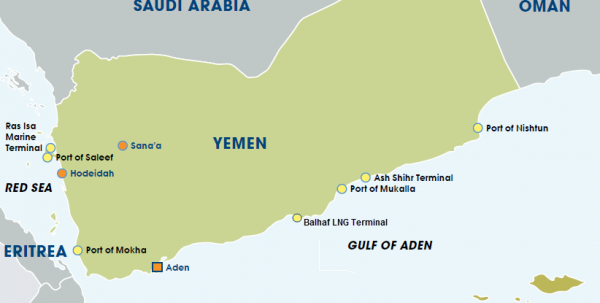Gard released an update, after it received information fromthe Gulf Agency Co. Ltd. (GAC), regarding the port situation in Yemen as it stands on 22 January 2018, informing on what ports are open and which are closed.
According to the report, the ports that are working in Yemen are:
- Aden
- Mukalla
- Ash Shihr Terminal
- Nishtun
- Saleef
- Hodeidah
The port that are closed are the following:
- Mokha
- Ras Isa Marine Terminal (Safer)
- Ras Isa Petroleum Products Reception Facility
- Balhaf LNG Terminal
The capacity of the open ports may, however, be limited, with cranes not being unavailable and there may be a lack of fuel supplies and other basic services. All vessels entering Yemeni ports may experience postponements and delays.
The situation can change quickly and operators are advised to warn their vessels’ crews of the volatility of the situation and to carry out an assessment of the risks involved prior to entering or transiting Yemeni waters.
Moreover, shipping companies shipping commercial goods or services to ports not under the direct control of the Government of Yemen must notify and apply for a Certificate of Clearance via UNVIM, which has to be submitted upon departure from the port of origin of their cargo and at least five days prior to arrival at their port of destination in Yemen.
Vessels that are under the control of the Government of Yemen, still need clearance from the Saudi Arabian-led coalition prior to entering Yemeni waters, and a copy of the Ministry of Transport’s form “Entry permission for commercial and relief ships to Yemeni ports” should be completed and sent by email to the Operations Unit of the Evacuation and Humanitarian Operations at: [email protected] not less than a week before vessel’s entry/arrival. Entry to Yemeni territorial waters will be permitted only after an inspection is done by the naval forces of Saudi Arabian-led coalition.
Once a vessel reaches Bab-el-Mandeb, some 3nm from Yemen’s territorial waters, a notice of arrival must be called in by the Master on VHF channel 16. The naval forces of the Saudi Arabian-led coalition will then advice where the vessel should anchor. Once the vessel is permitted to enter port, the Master must register the vessel’s arrival with the port authorities (on VHF Channel 14 or 16) and will then be assigned an anchoring position until the berthing time is confirmed by the Harbour Master.
Because of the volatile situation in Yemen, operators are advised to obtain the most up to date and reliable security information available at any given time and assess the current security situation before entering Yemeni waters.
“We would also like to emphasise the importance of closely following the guidance provided by the Interim Guidance on Maritime Security in the Southern Red Sea and Bab al-Mandeb and the BMP4 when operating in the Red Sea and Gulf of Aden region. Vessels should register with the United Kingdom Maritime Trade Operations (UKMTO) and Maritime Security Center Horn of Africa (MSCHOA) prior to entering the region and use the Maritime Security Transit Corridor (MSTC), which is a military established corridor upon which naval forces focus their presence and surveillance efforts,” Gard added.
Additionally, according to the US Maritime Transportation Security Act (MTSA), the USCG is required to assess the effectiveness of antiterrorism measures implemented in foreign ports from which US documented vessels and foreign vessels depart on a voyage to the US and other foreign ports believed to pose a security risk to international maritime commerce. Under the conditions of entry, the affected vessels have to:
- Implement measures as per the ship’s security plan equivalent to security level 2 while in port in Yemen.
- Ensure that each access point to the ship is guarded and that the guards have total visibility of the exterior of the vessel while it is in port in Yemen.
- Attempt to execute a declaration of security while in port in Yemen.
- Log all security actions in the ship’s security records.
- Report the actions taken to the relevant Coast Guard captain of the port prior to arrival in US waters.


































































